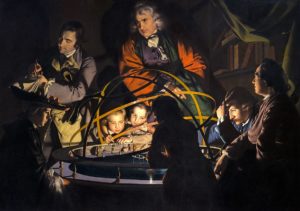 Paul Rosenberg - Freeman**Q**s Perspective
Paul Rosenberg - Freeman**Q**s Perspective
IPFS
Earned Knowledge, L3, P1
Written by Paul Rosenberg Subject: General Opinion Variations And The End of The Model
Variations And The End of The Model
As we mentioned in Lesson #2, once hard and aggressive people in other places knew that kingship worked so well in Mesopotamia, they began to copy it. And so the "kingship from Eridu" model began to spread all through the ancient Near East. But while all of them copied Mesopotamia, they weren't entirely the same.
The largest and most successful of these variations of Mesopotamian kingship occurred in Egypt. And there was a very strong reason for that: People living in Egypt had almost no way to leave.
In Mesopotamia, there were two major rivers plus several smaller ones, many other cities, and "tent people" beyond them. But for Egyptians, the only other place to go was the desert, where almost nothing could grow and survival would be terribly difficult. Look at the green and tan areas on the map below. The green areas are where food could be grown, the tan areas are where no food could be grown.
 The green area surrounds the Nile river, which flooded each year, like the rivers of Mesopotamia. And so, any king who could control the river – with boats and thugs – could take things away from the farmers whenever he liked; there was nowhere to run away to.
The green area surrounds the Nile river, which flooded each year, like the rivers of Mesopotamia. And so, any king who could control the river – with boats and thugs – could take things away from the farmers whenever he liked; there was nowhere to run away to.
But even here, ruling by force alone ("Give it or else") didn't work terribly well. For the farmers to work hard, they needed to feel good about what they did. And so, at about 3,100 BC, the Egyptian rulers began to follow the Eridu model of getting the farmer to believe it was a holy duty to give crops and animals to the king.
The Egyptians used different gods and rituals, and created new stories. And rather than hundreds of individual cities, Egypt was a long string of farmers living next to the river, and giving their grain to the king's men as required. (These kings called themselves Pharaohs.)
Egypt had a central ruler, who had only to control the river and lands within a few miles of it. These kings gathered immense wealth to themselves, and began to build great monuments. The purpose of their monuments (many of which still exist) was to accentuate the importance of the king and his kingdom… to convince people of their power and importance.
The Egyptian stories presented the king (the Pharaoh) as much more than just a man, and crucial to their relationship with the gods. And, of course, the farmers were told that if they failed to do their sacred duties, the gods would withhold their blessings from them.
Below is an engraving from about 2,400 BC, showing how Egypt taxed the farmers, in addition to taking a portion of their grain: The rulers required the farmers to work for them a certain number of days per year. Those days would usually be in the quietest times of the year (when no farming needed to be done), but it was enforced with punishments. This arrangement is called corvée (kor-vee).

Starting on the right (Egyptians often wrote from right to left) are scribes keeping track of people and duties. On the left we see armed men forcing people to go to the specified place and do as they were commanded.
We have a description of this from a later period (about 1,350 BC), where a regional ruler complains that he is the only good "cultivator" for the king; that he's the only one making his subjects work for the Pharaoh.
May the king, my lord, be aware of his servant and his city. In fact, only I am cultivating in Sunama, and only I am furnishing corvée workers. But consider the mayors that are near me. They do not act as I do. They do not cultivate in Sunama, and they do not furnish corvée workers. Only I, by myself, furnish corvée workers.
These rulers either created their own religion or adapted it from previous beliefs. And it was at Egypt that the first stories of heaven and hell formed. As we mentioned in Lesson #2, the Sumerians believed in a dreary underworld for the dead, not a heaven or a hell.
The idea of heaven began at about 2,400 BC, but it was available only to the king. "Heaven" meant the realm of the stars; what we would call "space." The Egyptian "Pyramid Text" described it this way:
The gatekeeper comes out to you, he grasps your hand,
Takes you into heaven, to your father Geb (one of the gods).
He rejoices at your coming, gives you his hands,
Kisses you, caresses you,
Sets you before the spirits, the imperishable stars.
Later, after a change in ruling groups, the idea of heaven was expanded, so it wasn't for the king only. It was also at this time (about 2,100 BC) that the idea of hell began. Older stories of the underworld were now retold with fiery rivers and lakes, and with demons who terrorized bad people.
From this time onward, it was taught that after death, a person would stand before forty-two divine judges and then go to a good place ("the Field of Rushes") or to a "lake of fire," where they were punished, then annihilated. (This hell was not an ongoing, eternal punishment. Once the bad person was burned up, they were permanently dead and gone.)
**
Paul Rosenberg
freemansperspective.com
* * * * *























